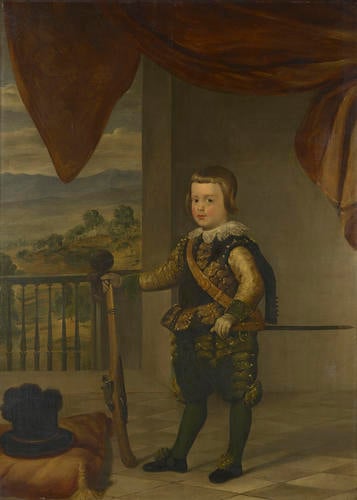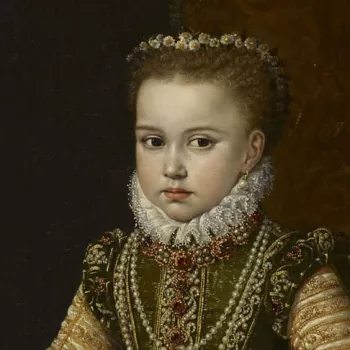Prince Balthazar Carlos of Spain (1629-1646) c.1660-68
Oil on canvas | 157.5 x 113.3 x 3.4 cm (support, canvas/panel/stretcher external) | RCIN 403017
-
Balthasar Carlos was born on the 17 October 1629, the only son of King Philip IV and his first wife Isabella of Bourbon (1602-1644). He was heir apparent to all the kingdoms, states and dominions of the Spanish monarchy, with titles including Prince of Asturias, Prince of Girona, Duke of Montblanc, Count of Cervera, Lord of Balaguer and Prince of Viana. Prince Balthasar Carlos died of smallpox on the 9 October 1646 aged sixteen.
This portrait of Balthasar Carlos is a copy after that by Diego Velázquez and workshop dated 1636, now in the Mueso del Prado, Madrid (PO1233). It was previously thought that the painting was a nineteenth century copy after Velázquez by Carlos Luis de Ribera y Fieve; however, there is no evidence to support this late dating or attribution.
The portrait depicts Balthazar Carlos aged around six wearing hunting attire. His left hand rests on the hilt of his sword, while his right is on the barrel of an upright rifle. The landscape background appears to show the Sierra de Guadarrama mountains, suggesting that the Prince may have been painted in the Torre de la Parada hunting lodge in the Monte de El Pardo area of Madrid. The original composition upon which the Royal Collection painting is based is part of a group of portraits of the young crown prince that reference the theme of hunting, primarily by Velázquez and his studio. The group includes another version of this composition showing the Prince in an interior with the addition of three dogs, in the collection of the Duke of Abercorn, and a further version recorded in Paris in 1928 (E. Jonas, no. 280). There are also several similar portraits of the Prince in hunting attire in a landscape setting, one by Velázquez (1635, Museo del Prado) of which there is a studio copy at Ickworth (National Trust) and another attributed to Alonso Cano (1633-34, Museum of Fine Art, Budapest). Additional portraits on the same theme include The Riding Lesson of Balthasar Carlos (Collection of the Duke of Westminster) and Balthasar Charles on Horseback (1635, Museum del Prado) both by Velázquez.
Compositionally, several of the paintings in this group are similar in type to portraits of King Philip IV of Spain, including the equestrian portrait by Velázquez and a portrait of the king in hunting attire in a landscape, also by Velázquez, both in the Mueso del Prado. The similarities suggest continuity between Father and Son and the continuation of the Habsburg line. The children of the Spanish Habsurgs and the higher echelons of Spain's nobility were instructed to behave in both a formal and upright, Catholic manner from a very young age. This is reflected in the court portraiture of the younger members of the Habsburg House. Rather than being portrayed as child-like, they appear conscious of their status and exemplify princely virtues. Hunting, in addition to being a passion of the Spanish Habsburgs, was also an allusion to war and in the context of portraits of Balthasar Carlos, suggested the military responsibilities that awaited him as the future king.Provenance
Purchased by Gruner on behalf of Queen Victoria from the collection of King Louis Philippe, as a copy after Velazquez attributed to Carlos Luis de Ribera y Fieve, Messrs. Christie & Manson, 7 May, 1853, Lot 134, £8
-
Creator(s)
Acquirer(s)
-
Medium and techniques
Oil on canvas
Measurements
157.5 x 113.3 x 3.4 cm (support, canvas/panel/stretcher external)
172.6 x 128.0 x 6.7 cm (frame, external)
Category
Object type(s)










